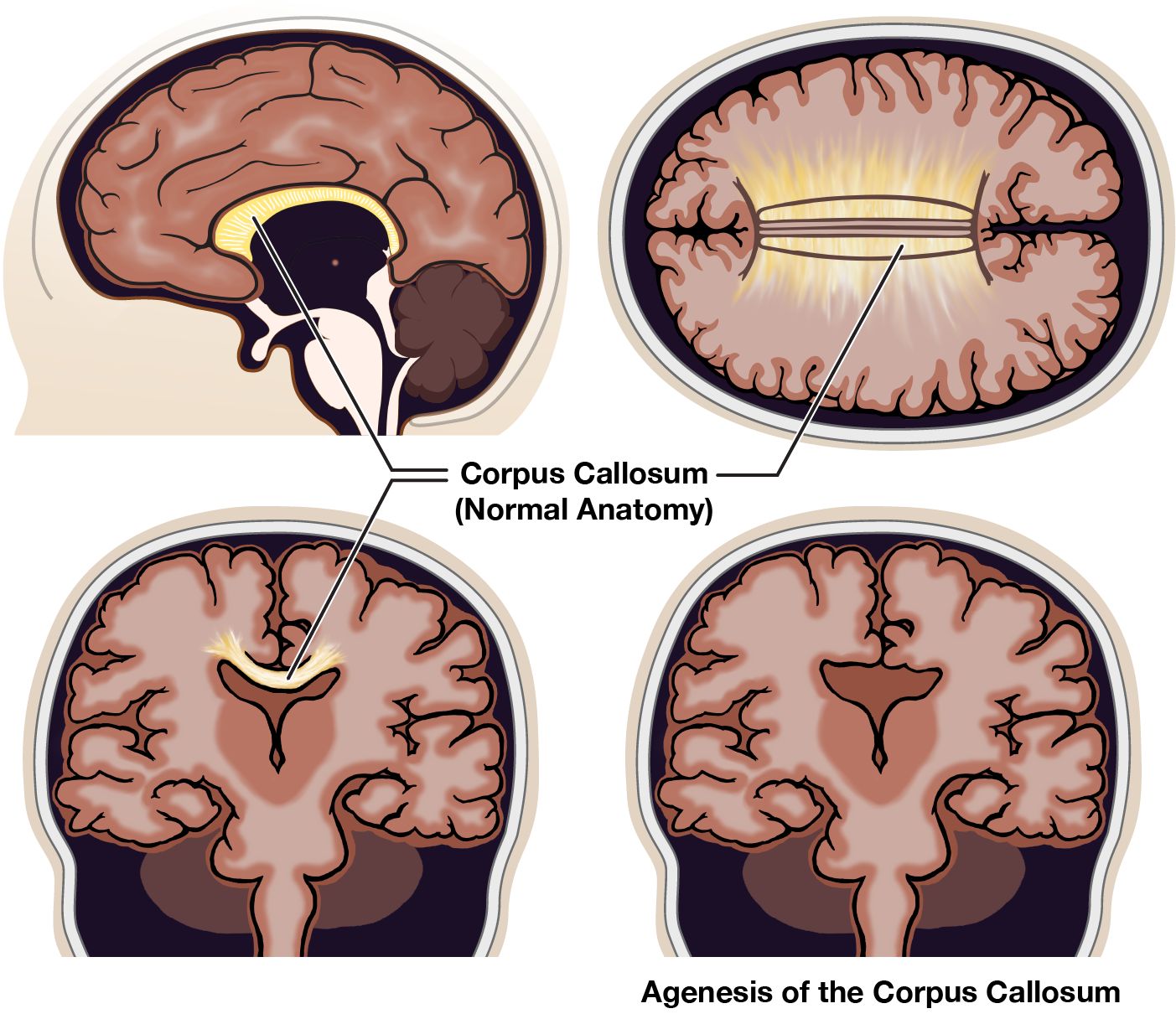What is agenesis of the corpus callosum?
The corpus callosum is a collection of many millions of nerve fibers in the middle of the brain. One of its functions is to connect the right and left sides of the brain to allow for communication between the two sides, or hemispheres. The corpus callosum coordinates signals from different parts of the brain and helps us in our thinking.

Agenesis of the corpus callosum is a birth defect in which this structure in the brain is either partially or completely missing. It may occur as an isolated brain problem, in combination with other brain abnormalities, such as ventriculomegaly, or in combination with problems with other organs, such as a congenital heart defect.
Agenesis of the corpus callosum is caused by disruption of the development of the fetal brain. This disruption may be related to chromosome errors, genetic factors, prenatal infections, or other factors related to the prenatal environment. In most cases, it is not possible to know what specifically caused the disruption.
What is the outcome with agenesis of the corpus callosum?
Some children with agenesis of the corpus callosum have a normal outcome, and some have only mild learning difficulties. Other children may have severe disabilities such as cerebral palsy, intellectual or learning disabilities, autism, and/or seizures. Whether a child has these symptoms or difficulties depends partly on whether other brain development problems are detected on MRI and whether there is a problem with the child’s chromosomes.
Throughout childhood, the nerve fibers of the corpus callosum continue to grow and become more efficient, even through the teenage years. At this phase in their development, children with a normally formed corpus callosum make progress in their abstract reasoning and problem solving, and their social skills mature. A child with agenesis of the corpus callosum may keep up with his or her peers until this age; however, they may begin to fall behind in schoolwork and social functioning. Therefore, the symptoms of agenesis of the corpus callosum can become more evident as a child grows into adolescence and young adulthood.
How serious is the agenesis of the corpus callosum in my fetus?
If your doctor sees a problem with the corpus callosum, they may refer you for several tests, if these have not already been done. These include a more detailed ultrasound (often times called “Level II ultrasound” or “Fetal Survey”), amniocentesis (to look at the genetic makeup of your fetus, and to look for any signs of infection), and fetal magnetic resonance imaging (Fetal MRI).
Fetal MRI is another way to safely look at your fetus’s brain. It provides detailed pictures of your fetus’s brain using different technology than ultrasound. Because it uses a different technology, fetal MRI can detect other problems in your fetus's brain that cannot be detected on ultrasound. We can then look at the results from all of the tests together and your physician can speak with you about the significance of these test results.
For more information on Fetal MRI please visit UCSF Baby Brain - Fetal MRI
What treatment is available for agenesis of the corpus callosum?
There is no specific treatment before birth for fetuses with agenesis of the corpus callosum. Treatment after birth involves managing the child's symptoms, as well as supporting development and learning. It is important during your pregnancy to get a detailed diagnosis (via detailed ultrasound, amniocentesis, and MRI) in order to determine if there are any additional problems. Our staff can talk to you about these test results and inform you of what challenges you may expect. We can help direct you to the appropriate specialists whatever the test results show.
Support Groups & Other Resources
- National Organization for Disorders of the Corpus Callosum — an organization to provide information and a communication link for individuals with brain anomalies involving the corpus callosum, their families and the professionals who work with them.
- March of Dimes — Researchers, volunteers, educators, outreach workers and advocates working together to give all babies a fighting chance
- Birth Defect Research for Children — a parent networking service that connects families who have children with the same birth defects
- Kids Health — doctor-approved health information about children from before birth through adolescence
- CDC - Birth Defects — Dept. of Health & Human Services, Centers for Disease Control and Prevention
- NIH - Office of Rare Diseases — National Institute of Health - Office of Rare Diseases
- North American Fetal Therapy Network — NAFTNet (the North American Fetal Therapy Network) is a voluntary association of medical centers in the United States and Canada with established expertise in fetal surgery and other forms of multidisciplinary care for complex disorders of the fetus.